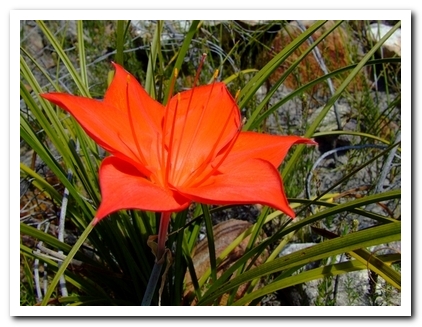
Bredasdorp lies at the
foot of the Heuningberg Mountain, home to the
Heuningberg Nature Reserve. The Reserve more
than rewards the visitor who wanders its numerous contour paths.
On clear days, the summit boasts spectacular
views in all directions, east to Arniston and De Hoop and south to Struisbaai
and the Soetanysberg. To the south-west, you
can see Elim and to the north, the visitor is rewarded with magnificent views across
the Rûens to the Riviersonderend
Mountains.
There is always an abundance of beautiful flowers to delight the visitor.
This Reserve is home to more than 260 species
of plants, 34 of which are endemic and a number of these, e.g. the Bredasdorp Lily (Cyrtanthus guthriea), are
found only on the Heuningberg Mountain. Other plants
include various orchids, Proteas (P. compacta, P. neriifolia P. cordata
and others) Serrurias, Ericas and many others.
The visitor will always find
flowers in bloom from tiny Lobelias to giant Proteas (P. cynaroides),
from delicate Painted Ladies to Everlastings each in its own season.
If one is lucky, you may even catch a glimpse
of the shy small buck ("duiker", "klipspringer" and
"grysbok") which inhabit the mountain. Visitors virtually never get a glimpse of the elusive leopard that has on occasion been reported to visit the Reserve.
The Bredasdorp Nature Reserve, as it was
known when it was originally proclaimed on 16 September 1964, was only 68ha in
size and comprised mainly old quarries.
This area was restored by way of terraces that can still be seen in the garden
section of the Reserve today. Originally
planted with roses this was later replaced with indigenous plants and this
garden area is today about 80ha in size.
On 27 March 1986, the Reserve was enlarged to 800ha and it was given its
present name, Heuningberg Nature Reserve. The Reserve encompasses a large section of the mountain and an extra 400ha
of privately owned land to the south, the area around the Preekstoel rock, is
managed as part of the reserve. The
hiking trails were the brainchild of Eps Joubert, then a teacher at the Bredasdorp
High School, who recognised the unique
value of the Reserve and started with the clearing of alien vegetation. Alien
clearing is very important in the reserve, and whereas there were once patches
of pines, gums, myrtle and acacias (especially Acacia longifolia) the
area has largely been cleared of adult alien trees. However, the battle against these invaders of
our fynbos is never ending.

